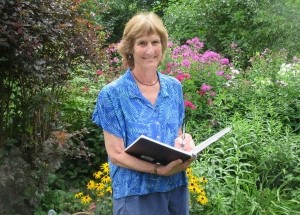Clare Walker Leslie is a naturalist, artist, and teacher. She has taught in twenty-nine states and written fifteen books. Her most recent book, How to Look at a Bird: Open Your Eyes to the Joy of Watching and Knowing Birds, is a beautiful introduction to birding and nature journaling. She lives in Cambridge, Massachusetts, and Granville, Vermont.
Why do you write?
I write for my own learning and to share what I know with others. I write to connect people with nature and to inspire curiosity.
You were an art history major and cellist in college, how did you come to be a naturalist and writer?
I never intended to do this. I graduated Carleton College in Northfield, Minnesota in 1968. I was not interested in nature. I came to Cambridge, taught art in an elementary school and spent time with my musical, creative, dark, and depressed friends. We never went outside. In the science building across the way, there was a woman my age, a naturalist. She was always upbeat. She came in after the weekend full of joy about the birds she’d seen and the places she’d been, and I thought, “Hmmm, something’s going on here. I’m in the wrong field.” I started hanging out with her, and it was such a mental, psychological change. I fell in love with nature and developed a hunger to be outside because it gave balance to my life as a wife, new mother, and teacher. It made me happy and continually curious.
I started teaching nature drawing in the mid 1970s. In 1978, I was approached by Prentice Hall to write a nature drawing book. I had not one interest in writing a book, but they helped me.
How to Look at a Bird is your 15th book. What inspired you to write it?
It turns out, I love writing books. It requires a discipline I learned from playing the cello. During COVID, my husband and I were living in rural Vermont and would go into the market. Many of the people I met there had bird feeders, or were hunters. We didn’t talk about politics or religion, but we could talk about birds. Those interactions inspired me to write a book for everyday people, to give them a place to start with bird identification and nature journaling.
Do you have another book in you? If so, what would you most like to write about?
A year ago, I lost my husband of 50 years. Grief is hard. I’m not writing right now, except for my nature journal, my 60th journal, but I’m thinking about a book on grief and the solace of nature. I’m not a therapist, but my solace is the nature of where I am, season by season, the birds, trees, sunsets, and hillsides.
What advice do you have for new writers?
Just write. Don’t comment on it, not yet. Just write. The criteria for writing are honesty, curiosity, and humility. And guard against being superficial.
What nature books do you recommend?
I cut my teeth on Rachel Carson, Aldo Leopold’s A Sand County Almanac, and Jane Goodall’s book on hope. I consider The Thunder Tree: Lessons from an Urban Wildland by Robert Michael Pyle, Bird Brother: A Falconer’s Journey and the Healing Power of Wildlife by Rodney Stotts, and Hawk of Mercy: The Activist Who Saved Nature from the Conservationists by Rosalie Edge to be required reading.
I recently read The Monarchs of Winghaven by Naila Moreira, a former student. I highly recommend it. (Moreira was the subject of this Writers in the Woods series in May 2024. That conversation and a link to her book can be found here.)
What gives you hope?
I’m personally having a hard time with hope right now after the loss of my husband. But hope and joy are what I’m teaching. I once encountered Yo-Yo Ma, my idol, in a market in Cambridge. I told him I thought he was the most amazing person. And this is his greatness: he turned to me and asked me who I am and what I do. I told him I gave up cello because I couldn’t do it all as a wife and mother and that I am a naturalist and teacher. He said, “Oh, so you and I are doing the same thing, traveling the country spreading joy.”
Hearing about the good work of young people around the world gives me hope. Being 77, I’ve seen major shifts in climate and species. My journals are really phenological studies that document these changes. I can look back on drawings with deep, deep snow and with snow drops not coming up until March. The perseverance of nature and the species we do have, despite it all, give me hope.
Do you have a favorite quote?
Yes, Henry David Thoreau’s quote, “In Wildness is the preservation of the World.” I like that he said wildness, not wilderness. That means everything wild, however small, including the insects that visit Northern Woodlands’ new pollinator garden.




Discussion *